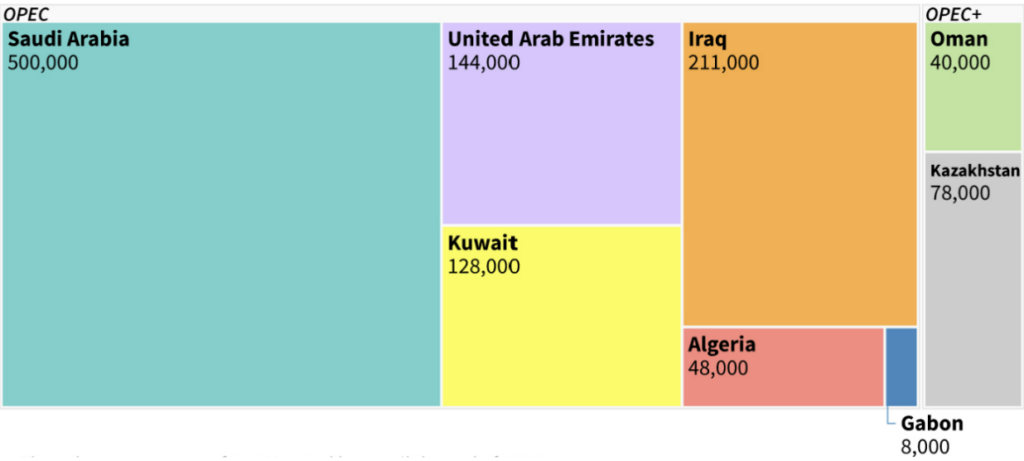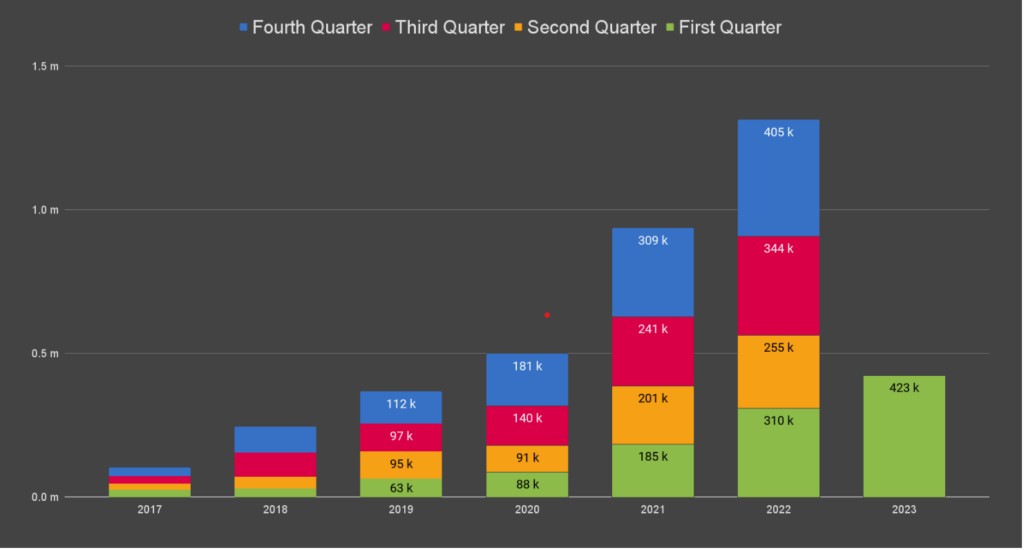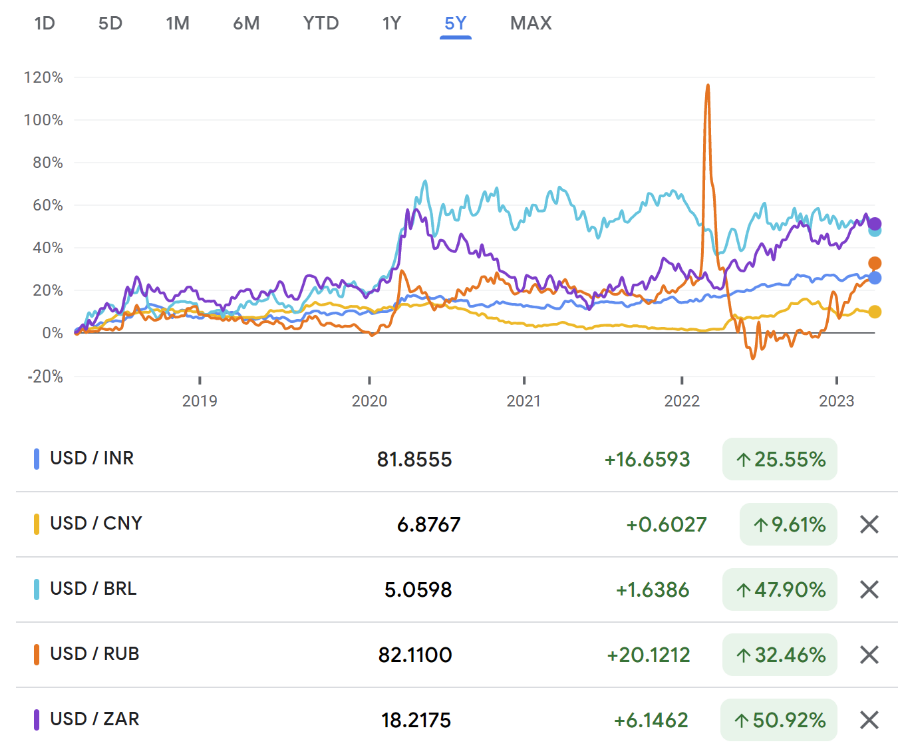
In this week’s market wrap we review:
- OPEC’s surprise oil production cuts and its implications
- Tesla’s latest Q1 vehicle delivery figures
- The implications of BRICS’ plans to create a new global digital currency
- Download the Syfe app and start investing in 12,000+ US and Aussie stocks today
1. OPEC+ announces surprise cuts in oil supply
On 2 April, Saudi Arabia and other members of OPEC+ announced a surprise oil production cuts of around 1.16 million barrels per day (bpd), in a move that made oil prices, like Brent Oil surge over 4% at the open. The total volume of cuts now stands at 3.66 million bpd, which equals 3.7% of global demand. The move came just one day before a virtual meeting of an OPEC+ ministerial panel, which had been expected to maintain the existing cuts of 2 million bpd until the end of 2023.

Source: Reuters
Why did it happen?
The unexpected announcement has been attributed to concerns over a possible demand reduction and the need to maintain stability in the oil market. Meanwhile, Russian deputy prime minister Alexander Novak stated that the cut is because of the Western banking crisis and ‘interference with market dynamics,’ which refers to a Western price cap on Russian oil. The cut might also punish oil short sellers or those who bet on oil price declines. Oil prices had fallen towards US$70 a barrel last month, the lowest in 15 months.
What does this mean for investors?
Cutting oil supplies can lead to a rise in its price, which could be sustained over a longer period of time. This in turn might lead to an increase in inflation levels at a time when the world is trying to fight inflation and it puts additional pressure on the US Fed. While the market expects a cut in interest rates in the medium term, the data-driven Fed can still further hike the rates if inflation levels are higher than expected.
2. Tesla hits record deliveries
Electric automaker Tesla reported record vehicle deliveries for Q1 2023, delivering 422,875 vehicles, up 36% year on year and 4% quarter over quarter, after price cuts. Tesla’s CEO, Elon Musk had set a goal of delivering 2 million vehicles this year, up 52% year on year from 2022. While a record number, the deliveries were below Wall Street’s average estimate of around 432,000 vehicles for the quarter, according to FactSet data.

Source: Next BIG FUTURE
The modest sales growth could be due to rising competition and a bleak economic outlook. In January, Tesla slashed prices globally by as much as 20% after missing Wall Street’s delivery estimates for 2022, sparking a price war among automakers. Tesla’s price cuts stoked demand, but investors may be concerned about eroding margins.
Other factors that may have affected demand include the potential reduction of U.S. electric vehicle subsidies, which could impact Tesla’s pricing competitiveness. Additionally, Chinese rivals such as BYD and Xpeng have been dropping prices to defend market share amid weakening demand. Finally, Tesla’s CEO has warned that the prospect of recession and higher interest rates could lead to further price cuts to sustain growth, at the expense of profits.
3. BRICS creating a new currency
The BRICS nations, which includes Brazil, Russia, India, China, and South Africa, are reportedly working on creating a new digital currency to reduce their reliance on Western-dominated monetary systems. The proposed currency, which could be backed by assets like gold, aims to facilitate trade and investment among the nations while providing a more stable and secure currency for international transactions.

Source: Google Finance
If successful, the new currency has the potential to challenge the dominance of the US dollar and the euro in international trade and finance, providing emerging economies with an alternative means of conducting transactions. It could also strengthen economic ties among the BRICS countries, promoting investment and growth within the bloc, potentially benefiting the global economy as a whole.
However, the creation of a new digital currency by the BRICS nations will undoubtedly face several challenges, including integrating the new currency into existing financial systems and establishing regulatory frameworks to govern its use. Gaining the trust and acceptance of the global financial community will also be crucial in ensuring the success of the new currency and its ability to challenge traditional financial systems.
Overall, the rise of a new global currency backed by the BRICS nations has the potential to transform the international financial landscape, leading to a more inclusive and diverse global financial system. The move highlights how important it is for investors to diversify assets based on geography as well.

Investing involves risk, including the risk of losing your invested amount. Any information that may be in this communication is general in nature only and is current at the time of writing. Syfe does not make recommendations of any kind or provide personal advice that take into account your objectives, financial situations or needs. You should therefore consider the appropriateness of the information in light of your own objectives, financial situation or needs before acting on such information, and/or speak to your financial or tax adviser for personal advice. Past performance figures are based on information provided by third parties and may not be accurate. Any references to past performance and future indications are not, and should not be taken as, a reliable indicator of future results. Syfe does not intend for any statement made here to relate to the acquisition or disposal of any shares in the companies or other financial products named here. Syfe makes no representation and assumes no liability as to the accuracy or completeness of the content of this communication.














